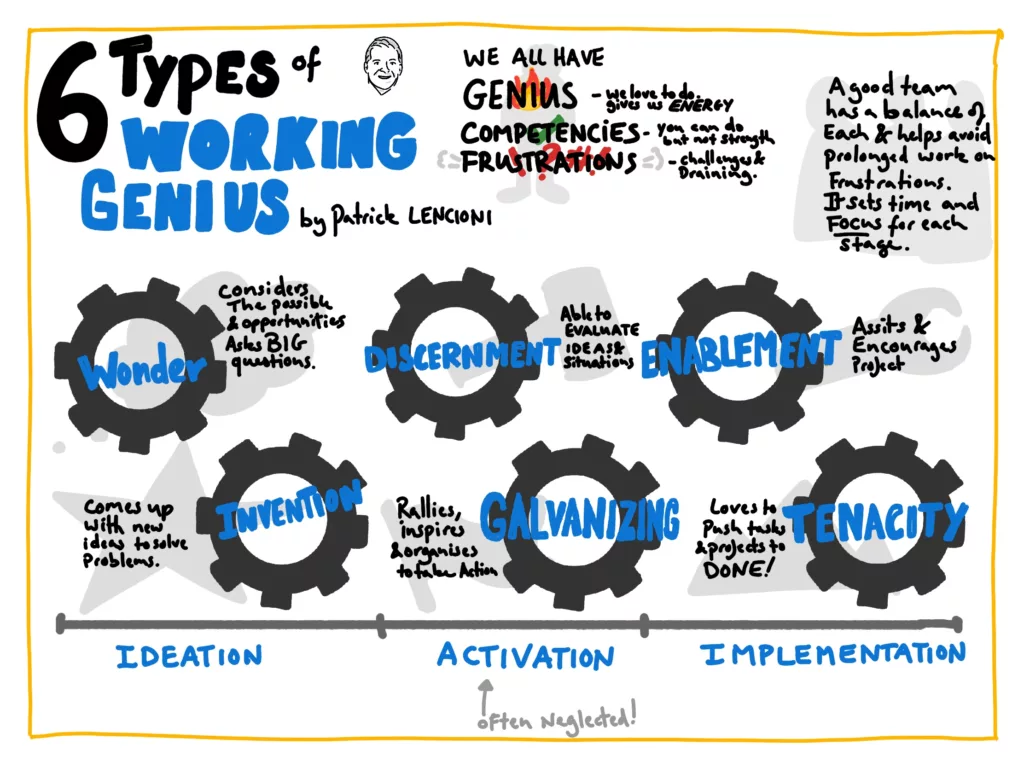We all have to do tasks at work that we don’t enjoy. It’s just a fact of work. But sometimes our work changes so we end up doing more of the work we dislike and less of the work that we’re gifted at and gives us energy. The 6 types of working genius is a framework to help prevent that.
This descriptive and prescriptive tool can help you get your employees to do work they really enjoy and are best at.
So stay tuned as we dive into what the framework is, how to identify your geniuses and how to apply the insights you learn.
The 6 types of working genius sketchnote

Get an overview of the key idea in the book with this 6 types of working genius sketchnote.
What is a working genius?
A working genius is a part of work or projects that you are naturally gifted at and enjoy.
These are the activities that you look forward to doing and wish you could do all day. They’re the moments you light up in the workplace. 99% of us have two. Some people might have three or one but they might just not realise what their geniuses are.
What is a working competency?
A working competency is something you are good at, and don’t mind doing, but doing too much will drain you.
You shouldn’t avoid your competencies but you should spend more time in your working geniuses. It may be important for a team that you use your working competencies to fill the gaps and support someone who has that working genius.
What is a working frustration?
A working frustration is something you aren’t gifted at and don’t like doing.
They’re the parts of work that feel unnecessary, don’t come naturally to you or you can never really make a contribution. These activities are the most draining. It’s best to minimise how much you have to do, but it can also help to recognise this is a working frustration and try to embrace this mindset and let others contribute more.
The 3 key stages of a project
Each project has three key stages.
- Ideation
- Activation
- Implementation
Each stage is important to ensure we action the right plan, get people on board, and finish the work. Within each stage, There are two steps corresponding to a related genius.
It’s important to understand what stage a project is in and to ensure you have enough people with those working genius and competencies at each point. You may need to have people for whom it is a working frustration so that they are ready for the next stage, but you can set appropriate expectations.
The 6 types of working genius
There are 6 types of working genius.
- Wonder – A person with this genius is great at asking the big questions or identifying the problems that start a new project.
- Ideation – this genius is about coming up with novel solutions to a problem
- Discernment – Not all ideas are good ideas, and some need refinement. That’s what this genius does.
- Galvanising — Once the idea is ready, we need to share it, get people excited about it and outline the plan to see it through. That’s the galvaniser.
- Enablement — It might not sound fancy, but it’s essential. The enabler
- Tenacity — The last 20% can take 80% of a project’s time. Which is why tenacity is so important. These people push tasks and projects to done and ensure all the points are covered.
Key actions you should take to gain the benefits of this framework
There are four key implications of this framework.
One personal, and three for teams.
- As an indvidiual, identify your working genius, competencies and frustrations then maximise your genius while minimising your frustrations.
- As a manager, help your team members to identify their genius and help them to maximise and minimise appropriately.
- When running a project, identify the stage you are at and make sure you have the people with the right working genius and competencies at the right time.
- Identify gaps in your teams working geniuses and seek to plug them. If you can’t, make sure you share the load of working competencies so you don’t overload individuals.
By implemnting these changes, both you and your team will be more productive and satisfied with your work.
Want to learn more?
If this has whet your appitie, you can buy the book. It goes into more depth of the model and has a fable at the start to help explain it too.
If you enjoyed this post, you might like my other sketchnote summaries of books — they’re free.

Leave a Reply